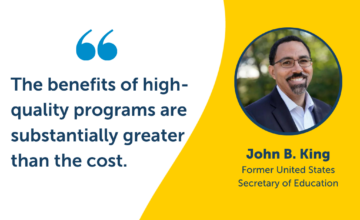At the core of the practitioner-immigrant family relationship there must be a developing understanding of the strengths of the families and their story of courage and sacrifice.
by H. Victoria Prieto, Co-Director, Transcultural Innovation, ZERO TO THREE
Many families who decide to move to the United States of America do so seeking a new beginning and the prospect of a better life their country of origin may not afford them. As an immigrant myself, I can say that moving to a culture other than the one I grew up in posed unexpected challenges. However, my story does not compare to the millions of poor families for whom migrating to the U.S. is often a traumatizing event. Their stories comprise an unpredictable future and painful decisions to leave family members behind only to later face reverse separation. Parents who are deported leave behind their young children, most of whom are U.S. citizens. It is estimated that more than one in five children in the United States are children of immigrant families.
Against this backdrop, the work with immigrant families has vast implications. In particular, the educational outcomes for young children is largely dependent on a competent early care and education workforce who can successfully work in a context of diversity and whose professionalism is called to action when working with disadvantaged immigrant populations. This work demands cultural approaches which differ in important ways from the work with families who are not experiencing ambiguous circumstances. At the core of the practitioner-immigrant family relationship there must be a developing understanding of the strengths of the families and their story of courage and sacrifice. it is not surprising that the common denominators among immigrant families are their strong desire that their children not endure what they endured to get to the U.S. and their hope for a better future for them.
So, what could practitioners do to improve outcomes for immigrant children and their families? Those who are perhaps most at-risk are undocumented immigrant families and children. Below are a few considerations from which practitioners can derive their family engagement practices and approaches to work with immigrant families.
- Understand the web of relationships in any given family and how they connect. It involves those who migrated across international boundaries, those who were left behind in the country of origin, and those in the immigrant family who risk going back and forth to maintain emotional and/or economic ties. An element of interconnection across borders is very prevalent.
- Of special importance is conversations with families about their story. While this cannot be accomplished until there is a bank of trust built between practitioner and family, recollection of experiences increases the odds of emotional continuity. Immigrant families feel legitimized when someone takes interest, understands, and honors their experience.
- Immigrant families most likely come from a culture where a three-generation approach to raising children is the norm. When parents and children are separated, practitioners can support families by reassuring them that if they stay in constant communication with their children and their caretaker, the parent-child bond will prevail. Most likely, the children left behind are surrounded by a grandmother and other loving adults.
- While immigrant families are motivated to maintain the culture of their home country, they are also motivated to explore the U.S. culture.
- Support families by showing them ways to increase connections through technology, email, or phone. In addition, if possible, connect with the caretakers in their country to encourage them to send photos or letters to the departed parent.
- Help immigrant families connect with community-based supports including health and nutrition, mental health, home visiting programs, and, in particular, facilitate networking with their cultural community in the U.S. by introducing them to families who share similar stories.
- Inform families whether the state where they reside offer any supports for non-citizens.
- Facilitate immigrant families’ access to early care and education and pre-K programs. Young children of immigrants are underrepresented in such settings, an element of concern as it can affect their future success in school. Immigrant parents place a high value on education, and in fact, education is often one of the primary reasons why they migrate to the United States.
Eliminating accessibility barriers for immigrant families and their young children is a matter that requires effectively responding to their needs and understanding of their contributions to our society. The early care and education field, social workers, and others in the infant and family field are in a good position to make a difference for this vibrant sector of the population.
Read more about this topic in the ZERO TO THREE Journal (March, 2015) article:
Complex Intervention: An Immigrant Family’s Story of Loss, Struggle, and Perseverance
By Wanjiku F. M. Njoroge
Children’s Hospital of Philadelphia, Pennsylvania
Abstract: This article reveals the complicated relationships among culture, family, trauma, and service delivery for immigrant families. The author describes a family who first came into contact with the service delivery system referred by the pediatrician, whose practice was an important point of entry for the early childhood work that followed. The family required close collaboration among a team of early childhood specialists, including infant/preschool psychiatry, social work, early intervention services, and interpretive services across three different institutions and settings. This story highlights the importance of multidisciplinary work and the difficulties involved in attempting to meet the needs of culturally diverse and complex families.



